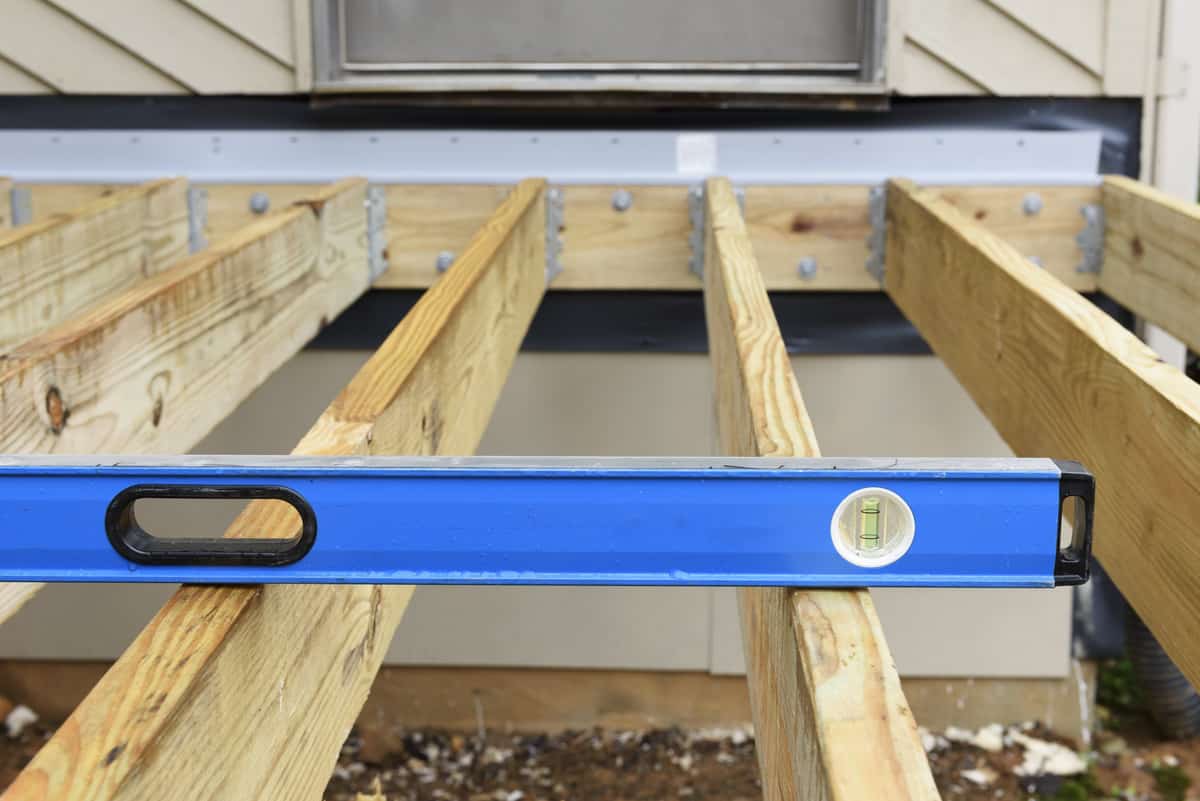
What’s the Proper Joist Spacing for Composite Decking?
After weighing the options, you’ve decided you want to use composite material to build your deck or replace your old wood deck. Composite decking, which is made from a combination of wood and plastic, lasts longer than traditional wood because it’s less prone to rotting, splintering, and insect damage. But to truly get the most out of your new composite deck, you have to start with a strong frame.
Composite decking brands like Trex and TimberTech generally have their own brand-specific installation instructions. But sometimes, they can be a bit unclear when it comes to a crucial component – deck joist spacing for composite decking.
Most joist spacing for most composite and PVC decking brands, such as Trex, AZEK, TimberTech, and Fiberon, require a minimum joist spacing of 16″ on-center for straight decking and 12″ on-center for diagonal decking at a 45-degree angle. Some brands, like WearDeck, let you get away with more – reinforced with a layer of fiberglass on both the top and bottom, WearDeck boards easily allow for spans of 24 inches OC. What’s really necessary?
In this guide, we’ll go over the proper joist spacing as well as some common installation mistakes you should avoid.
Why is Joist Spacing So Important for Composite Decking?
A house is only as strong as its foundation, and a deck is only as strong as its frame. If the composite deck’s floor joists that span the length of your deck are installed too far apart, the boards on top will sag. If the joists are not all the same exact height, the deck’s surface will be uneven.
It’s common sense that the less space there is between joists, the sturdier your deck will be. However, if you space your joists too close together, it will be difficult to install supporting elements such as joist hangers, blocking, and flashing.
What Does “On Center” Mean?
The distance between two deck joists is measured in inches “on center”, commonly abbreviated as “OC”. If you were to draw a line down the center of two joists and then measure the distance between them as 16 inches, that measurement is 16 inches on center.
Basically, instead of measuring joists from edge to edge, you should measure them center to center.
How Far Apart Should You Place Floor Joists on a Composite Deck?
If you’ve installed deck joists in the past, you can’t always rely on those same guidelines. Composite materials have changed drastically over the years, improving in both performance and appearance.
At the same time, local building code requirements have also become stricter. For example, towns that once required a maximum of 16” OC for composites may now require 12” OC.
12 inches, 16 inches, or 24 inches?
When would you ever need to use 12 inches OC? Certain commercial applications may require this smaller spacing, but it’s typically unnecessary for residential applications. That is unless you’re installing your deck at a 45-degree angle – in this case, 12 inches OC is recommended by most composite decking brands.
The bottom line? With composites, you can typically trust brand guidelines. However, you should make adjustments depending on the angle and span of your deck.
Joist Spacing & Span
The distance you choose affects the maximum joist span, or how long your joists can be without compromising the strength of the deck frame.
The smaller the spacing, the longer your joists can span. Your composite decking manufacturer will have a unique joist span table to help you determine the maximum length based on joist size and spacing.
Tips for Properly Installing Composite Decking Joists
Your deck can begin to fail prematurely if the framing is weak. Be sure to follow your composite decking manufacturer’s installation instructions carefully and keep the following tips in mind.
- Make sure your joists are as level as possible. As you’re installing them, run string lines across the tops of the joists frequently. You may need to cut away parts that are too high or install shims where joists are too low.
- Support your joists with blocking. Blocking is a common technique that involves putting small pieces of decking material between joists to increase rigidity and prevent them from twisting or sagging. Blocking can be done along the perimeter of the frame, mid-span, or both.
- Check for protruding nails and screws. Finally, give the frame a final once-over to make nails and screws are flat and that all of the joists aren’t showing any signs of distress.
A few extra hours perfecting your deck frame can mean extra years on the life of your deck, so it pays to take your time.
Next Steps
Once your deck’s floor joists are properly spaced, leveled, and secured, you can move on to the next step: laying down the boards. For a cleaner finish, use hidden fasteners to install your composite deck boards instead of screws. Finally, you can add the finishing touches – posts, railing, skirting, and anything else you can dream of.
From frame to finish, Decks & Docks has everything you need to complete a composite decking project. Our selection of marine-grade composite decking materials are a favorite of homeowners and seasoned contractors alike. With a wide variety of accessories, railing styles, and hardware, you won’t have to look anywhere else.
Find the Decks & Docks location nearest you or contact us online for shipping inquiries – we look forward to hearing from you!
- About the Author
- Latest Posts
Dan has worked for Decks and Docks for over twenty-five years. He managed the original Decks and Docks store in St. Pete, which is our largest store. Dan is simply the best all around. He knows more about this company and our products than probably anyone else. Dan currently works in Sales at our corporate office.
